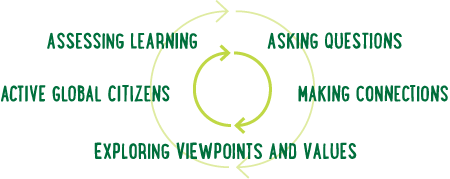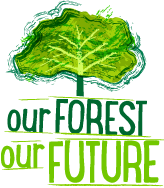How to use this resource...
Our Forest, Our Future helps teachers and pupils to explore the interdependence of people and forests and the vital role forests play in sustaining our environment – in the past, the present and hopefully the future.
The Scots Pine forests in Scotland and the Congo Basin rainforest in Africa provide case studies through which pupils will begin to understand why our forests are under threat and the implications for our planet. Further information about these forests is provided in the following documents.
In making connections between consumerism, people and the environment, pupils will be encouraged to see how they and their actions have an impact on the lives of others globally. It encourages reflection on the possible futures of the world's forests and ways of taking positive actions for a future where people and forests co-exist in a sustainable way.
The resource is structured around a global citizenship framework devised by Oxfam.
More detail on the framework can be found in Global Learning Framework [pdf]
The reflection and evaluation sections in each activity support formative assessment and ongoing monitoring of pupils learning.
Additional assessment opportunities are indicated by... 
Outdoor learning opportunities are indicated by... 
Homework activities are indicated by... 

Taking Action for Change
Education for Global Citizenship is committed to enabling pupils to bring about positive actions for change either locally or globally. This process should support pupils to make their own informed choices through a critical evaluation of the options open to them and the possible implications of those choices.
Throughout the resource there are ideas for possible actions, such as reflecting on our power as consumers, peer education and tree planting. Your pupils themselves should be encouraged to think creatively about the many actions they could take, critically evaluate the impact these actions might have and then evaluate what they have done.
The materials below support your pupils through this process.
> Active global citizens
13. Where does our wood come from?
Aims
To understand that we are rely on people all over the world for wood
To reflect on the reasons why we should buy ethically sourced wood
To raise awareness among your school / local community about why and how we should buy ethically and sustainably sourced wood products
What to do
Show pupils the infographic 'sources of UK wood'. Ask pupils what information they can gather from the graphic. Highlight that the UK produces approximately 1/3 of all its wood. We import wood mainly from Europe and we import some special types of hardwood from the African rainforest. Wood from the African rainforest is used for a variety of things such as flooring, doors, kitchen work surfaces and furniture.
Remind pupils that there are a number of processes wood has to go through before it arrives in your home or school for use. Think about the people who might be involved in this process. What jobs might they have? Think about forestry workers, factory workers, furniture shops, shipping, etc. They could draw a map showing how something from their list of objects made in the wood survey reaches them. Discuss with the class how many different people are affected by the journey of wood using the teacher prompts below.
Show the class the FSC symbol. Ask if anyone has seen it before? What did they see it on? Does anyone know what it means? Ask the class if they can think of any other symbols which indicate to consumers that products have been produced to a particular standard. E.g. Fairtrade, Organic Soil Association
Watch one of the film clips from WWF or Who Cares about the Forest? Discuss the ways it encourages people to buy FSC products. Pupils might want to create posters or hold an assembly to raise awareness through the school. Further ideas for taking action can be found in the Active Global Citizens section.
Teacher prompts
- How do you think people such as forestry workers, timber factory workers or carpenters feel about wood consumption?
- What impact does it have on their lives?
- What impact can it have on the people and animals who live in the forest?
- Are people in other countries affected more by the cutting down of trees? Why?
Reflection and evaluation
We are connected to many different people who work in the timber industry in different countries in the world.
As consumers we have the power to affect the ‘supply chain’ and to support people’s rights to a sustainable livelihood.
Sustainable forestry can provide the landowner with more income than they’d get if they cleared the forest and used the land for farming.
Forests support up to 1.6 billion people (more than 1/5 of the world’s population) directly by providing food, jobs, medicines, fuel and materials for homes and household goods.
Homework
Ask pupils to find as many different products as possible which have the FSC label. They could revisit their original list of wood products from the wood survey task and see how many of those have the label.
Extension
Visit www.justforests.org/thinking-trees for links to videos showing how pencils and paper are made.
Teacher info: The Forest Stewardship Council (FSC) promotes environmentally appropriate, socially beneficial and economically viable management of the world’s forests. Each log has a tracking number which verifies its path from the forest to the shop and all the steps in between. Any product which is FSC verified will carry the logo and the tracking number.
The FSC tick tree logo is used to identify products from well-managed forests. These forests are managed with due respect for the environment, the wildlife and the people who live and work in them. Choosing FSC products where possible, and asking for FSC products where they are not available, creates a demand that feeds back through the supply chain and encourages more forest managers to reach the FSC’s high standards.
You can find the FSC logo on a whole range of products including toilet and kitchen roll, birthday cards, magazines, books, furniture, milk cartons and packaging.
![]() Teacher info
Scots Pine forest [pdf]
Teacher info
Scots Pine forest [pdf] ![]() Teacher info
Congo Basin rainforest [pdf]
Teacher info
Congo Basin rainforest [pdf]
![]()
![]()
![]()
